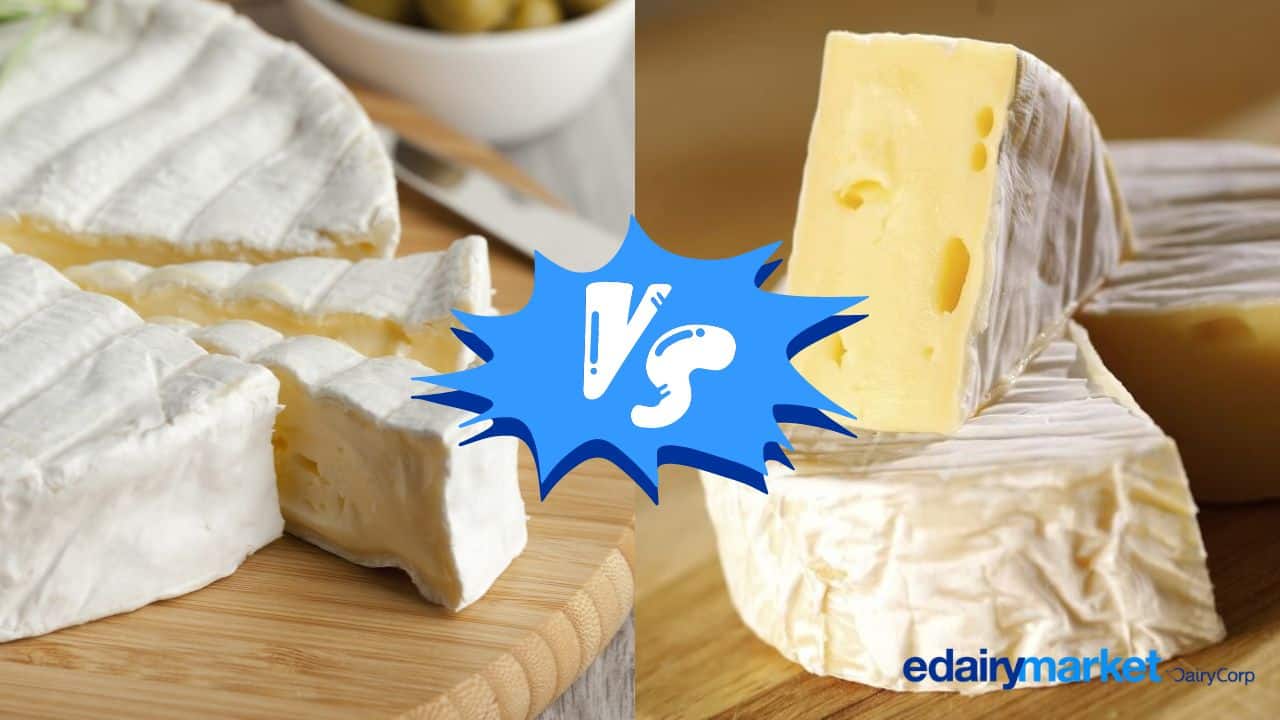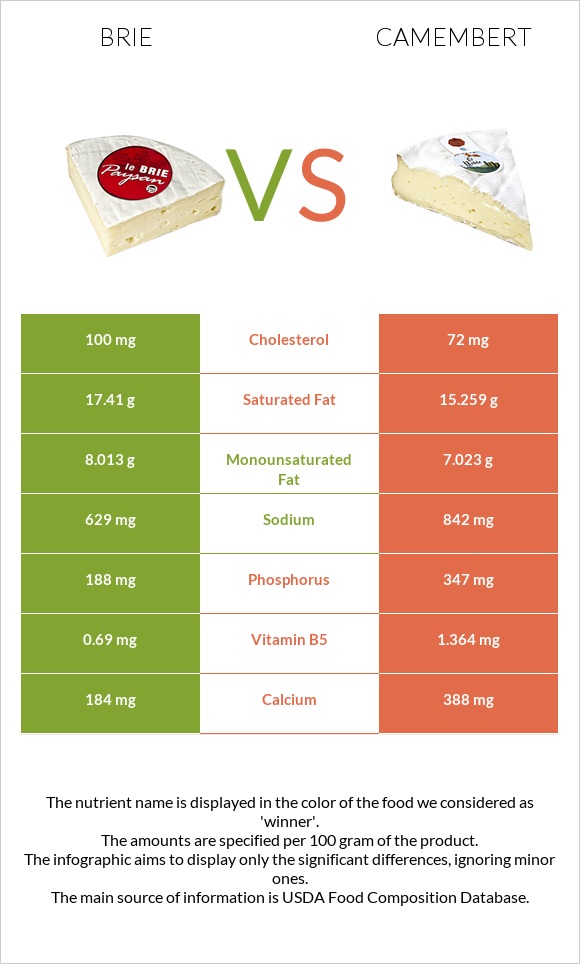Introduction
The Popularity Of Camembert And Brie Cheeses
Camembert and Brie are both popular cheeses that have captured the hearts and taste buds of cheese lovers all over the world. Known for their rich and creamy textures, these cheeses are often enjoyed on their own or paired with fruits, crackers, and wine. While they may appear similar at first glance, there are subtle differences that set them apart.
The Purpose Of This Article: Exploring The Differences Between Camembert And Brie
The purpose of this article is to delve into the distinct characteristics and origins of Camembert and Brie cheeses. By understanding the history and regional differences, cheese enthusiasts can gain a deeper appreciation for these beloved varieties. In the following sections, we will explore the origins, production methods, flavors, and textures of Camembert and Brie, providing a comprehensive guide to discern the differences between the two.
Origins
Camembert and Brie have different origins, which contribute to their unique qualities and flavors.
| Camembert | Brie |
|---|---|
| Originated in the small village of Camembert in Normandy, France | Originated in the region of Brie in northeastern France |
| Created in the late 18th century by Marie Harel | Believed to have been created in the Middle Ages |
| Initially made with raw cow’s milk | Made with both raw and pasteurized cow’s milk |
Origins And Regulations
The Regional Origins Of Camembert And Brie Cheeses In Northern France
The origins of Camembert and Brie cheeses can be traced back to different regions in northern France, which have influenced their distinct characteristics.
Camembert cheese originated in the small village of Camembert in Normandy, France, during the late 18th century. It was created by a local farmer named Marie Harel, who developed the cheese using raw cow’s milk. The unique microclimate and grassy pastures of Normandy contribute to the rich flavor and creamy texture of Camembert.
Brie cheese, on the other hand, originated in the region of Brie in northeastern France. Its exact origins are believed to date back to the Middle Ages, making it one of the oldest types of cheese in France. Unlike Camembert, Brie can be made with both raw and pasteurized cow’s milk. The natural resources and agricultural practices in the Brie region contribute to the unique characteristics of this cheese.
Protection Under AOC Regulations
Both Camembert and Brie cheeses are protected by Appellation d’Origine Contrôlée (AOC) regulations, ensuring that they are produced using traditional methods and in specific regions of France.
The AOC Camembert de Normandie can only be produced in the departments of Calvados, Eure, Manche, Orne, and Seine-Maritime, which are part of the Normandy region. This strict geographical indication ensures that the cheese maintains its authentic qualities and is made in accordance with traditional techniques.
The Brie region of origin, Île-de-France, is also protected under AOC regulations. These regulations define the specific methods and ingredients that must be used to produce Brie cheese in order to maintain its distinct flavor and texture.
By adhering to these regulations, both Camembert and Brie cheeses preserve their unique qualities and assure consumers of their authentic origins and production methods.

Flavor Profile
Camembert’s Stronger, Earthier Flavor And Aroma With Hints Of Mushroom And Garlic
Camembert cheese is known for its pronounced flavor profile. It has a stronger, earthier taste compared to Brie. The cheese has a distinct aroma, with hints of mushroom and garlic. The fermentation process of Camembert contributes to its slightly pungent taste, which adds depth and complexity to the cheese.
Brie’s Milder And Creamier Taste
Brie cheese, on the other hand, offers a milder and creamier flavor. It has a buttery taste with hints of sweetness and nuttiness. Unlike Camembert, Brie has a softer and more delicate flavor profile. The smooth and creamy texture of Brie makes it a versatile cheese that pairs well with various ingredients and accompaniments.
The difference in flavor between Camembert and Brie makes them suited for different culinary uses. Camembert’s stronger and more robust taste makes it a great choice for those who prefer bold flavors and want to add depth to their dishes. It pairs well with ingredients like cured meats, roasted vegetables, and crusty bread.
On the other hand, Brie’s milder and buttery flavor makes it a versatile cheese that can be enjoyed on its own or used in a variety of dishes. Its creamy texture is perfect for spreading on crackers or serving with fruits and nuts. Brie also melts beautifully, making it a popular choice for baked dishes like quiches and appetizers like stuffed mushrooms.
Whether you prefer the bolder taste of Camembert or the milder creaminess of Brie, both cheeses offer unique flavor profiles that can enhance your culinary creations. Experiment with different recipes and pairings to discover your favorite way to enjoy these delightful cheeses.
Fermentation Process
The Slight Pungency In Camembert Due To Its Fermentation Process
Camembert cheese undergoes a unique fermentation process that contributes to its distinct flavor profile. During the fermentation process, lactic acid bacteria are added to the milk, which causes the cheese to develop its characteristic tanginess. This tanginess is responsible for the slight pungency in Camembert, adding depth and complexity to its taste.
Brie’s Fermentation Process And Its Impact On Taste
Brie cheese also undergoes a fermentation process, similar to Camembert, but with some slight differences. The bacteria used in the fermentation process of Brie are different, resulting in a milder flavor compared to Camembert. The bacteria help to break down the lactose in the cheese, leading to the development of a creamy and buttery taste.
The fermentation process of both Camembert and Brie plays a crucial role in transforming the cheeses during aging. It allows the flavors to develop and intensify, creating their distinctive taste profiles. The length of time the cheeses are left to age can also affect their flavors and textures.
Overall, while both Camembert and Brie undergo a fermentation process, the specific bacteria used and the duration of aging contribute to their individual characteristics. Camembert’s fermentation process creates a slightly pungent taste, while Brie’s fermentation process results in a milder and creamier flavor.
Texture And Appearance
The Soft And Creamy Texture Of Camembert
One of the main differences between Camembert and Brie is their texture. While both cheeses are soft and creamy on the inside, Camembert tends to be denser and firmer. When you cut into a Camembert wheel, you will notice a slight resistance and a firmer texture compared to Brie. This denser texture is the result of Camembert being made with slightly less moisture and a higher protein content.
Brie’s Firm And Velvety Texture
On the other hand, Brie has a creamier and smoother texture. Its higher fat content gives it a luxurious mouthfeel that is often described as velvety. When you slice into a wheel of Brie, it will feel softer and have a smoother texture compared to Camembert. Brie’s texture is due to its higher moisture content and lower protein content, which contributes to its creamy and buttery consistency.
The texture of Camembert and Brie can also vary depending on their ripeness. As both cheeses age, they become softer and creamier. A ripe Camembert will have a gooey and runny texture, while a ripe Brie will have a luscious and spreadable texture.
In summary, the texture of Camembert is denser and firmer, while Brie has a creamier and smoother texture. These differences in texture contribute to the unique eating experiences of these two cheeses.

Aging And Ripening
How Aging Affects The Taste And Texture Of Camembert
One of the key factors that contribute to the distinct flavors and textures of Camembert is the aging process. As Camembert ages, it undergoes a series of biochemical changes that result in a more complex flavor profile.
During the aging process, the flavors of Camembert become earthier and more intense. The cheese develops notes of mushroom and garlic, giving it a robust and pungent taste. The longer Camembert is aged, the stronger these flavors become. Additionally, the texture of Camembert evolves during aging. It becomes denser and firmer, with a slight resistance when cut into, compared to younger Camembert.
The Ripening Process Of Brie And Its Impact On Flavor Development
Similar to Camembert, Brie also undergoes an aging process, which is known as ripening. Ripening allows Brie to develop its characteristic buttery and creamy flavor.
During the ripening process, Brie’s flavors mellow and become more delicate. It acquires a milder taste with hints of sweetness and nuttiness. The aging also contributes to the luxurious mouthfeel of Brie, as its higher fat content produces a velvety texture.
As Brie ripens, it becomes softer and creamier. The cheese transforms from a firm texture to a luscious and spreadable consistency. A fully ripened Brie will have a rich and creamy texture that melts in your mouth.
In conclusion, both Camembert and Brie undergo aging and ripening processes that significantly impact their flavors and textures. Camembert develops an earthier and pungent taste as it ages, while Brie acquires a milder and buttery flavor during its ripening process. The textures of these cheeses also differ, with Camembert being denser and firmer, and Brie having a creamier and smoother consistency as they age. These variations in taste and texture make Camembert and Brie unique and beloved choices in the world of cheese.
Pairings And Serving Suggestions
Ideal Wine And Food Pairings For Camembert
Camembert’s strong and robust flavor makes it a great choice for pairing with bold and full-bodied wines. Some ideal wine options to complement the flavors of Camembert include:
- Cabernet Sauvignon: The rich and fruity notes of Cabernet Sauvignon complement the earthy and pungent flavors of Camembert.
- Pinot Noir: The delicate and complex flavors of Pinot Noir enhance the distinct taste of Camembert.
In addition to wine, Camembert can also be paired with various accompaniments to enhance its flavors. Some suggestions include:
- Crusty baguette: The crisp crust and soft interior of a baguette provide a perfect contrast to the dense and creamy texture of Camembert.
- Walnuts: The nutty flavor and crunchy texture of walnuts complement the earthiness of Camembert.
- Apple slices: The fresh and crisp sweetness of apple slices add a refreshing element when paired with the rich and pungent flavors of Camembert.
Recommended Accompaniments For Brie
Brie’s milder and buttery flavor pairs well with lighter wines and complementary accompaniments. Here are some suggestions:
- Chardonnay: The creamy and buttery notes of Chardonnay complement the smooth and velvety texture of Brie.
- Sauvignon Blanc: The fruity and refreshing characteristics of Sauvignon Blanc pair well with the delicate and nutty flavors of Brie.
When serving Brie, consider accompanying it with the following:
- Baguette slices: Toasted baguette slices provide a crunchy base that enhances the creamy and spreadable texture of Brie.
- Fig jam: The sweet and slightly tangy flavor of fig jam adds a subtle contrast to the buttery taste of Brie.
- Grapes: The juicy and refreshing burst of flavor from grapes complements the mildness of Brie.
Overall, knowing the differences between Camembert and Brie allows you to make informed decisions when it comes to pairing these cheeses with the right wines and accompaniments. Whether you prefer the strong and robust flavors of Camembert or the milder and buttery taste of Brie, both cheeses offer unique experiences that can be enjoyed in various ways. Experiment with different pairings to discover your personal favorite combinations.
Camembert Vs Brie: Taste Test
A Comparative Analysis Of Camembert And Brie Based On Taste And Sensory Experience
Camembert and Brie, two beloved cheeses with similar techniques and characteristics, have distinct and subtle differences when it comes to taste and sensory experience.
Factors To Consider When Choosing Between Camembert And Brie
When choosing between Camembert and Brie, there are several factors to consider:
- Flavor:
- Camembert: Known for its strong and robust flavor, Camembert has earthy and pungent notes.
- Brie: Brie has a milder and buttery flavor, with a creamy and velvety texture.
- Wine Pairings:
- Camembert: Camembert pairs well with bold and full-bodied wines such as Cabernet Sauvignon or Pinot Noir. The rich and fruity notes of these wines complement the earthy flavors of Camembert.
- Brie: Brie pairs well with lighter wines like Chardonnay or Sauvignon Blanc. The creamy and buttery notes of these wines enhance the smooth and nutty flavors of Brie.
- Accompaniments:
- Camembert: Camembert can be enjoyed with crusty baguette slices, walnuts for added crunch and nuttiness, or apple slices for a refreshing contrast.
- Brie: Brie can be paired with toasted baguette slices for a crunchy base, fig jam for a subtle tangy flavor, or grapes for a burst of juicy sweetness.
In summary, while both Camembert and Brie are popular cheeses with their own unique characteristics, the choice between them ultimately depends on personal preference. Whether you prefer the strong and robust flavors of Camembert or the milder and buttery taste of Brie, both cheeses offer a delightful experience when paired with the right wines and accompaniments.
Conclusion
Recapitulation Of The Key Differences Between Camembert And Brie
Camembert and Brie are both delicious cheeses with their own unique characteristics. Here is a brief recap of the key differences between the two:
- Flavor: Camembert has a strong and robust flavor with earthy and pungent notes, while Brie has a milder and buttery flavor with a creamy and velvety texture.
- Wine Pairings: Camembert pairs well with bold and full-bodied wines such as Cabernet Sauvignon or Pinot Noir, while Brie pairs well with lighter wines like Chardonnay or Sauvignon Blanc.
- Accompaniments: Camembert can be enjoyed with crusty baguette slices, walnuts, or apple slices, while Brie can be paired with toasted baguette slices, fig jam, or grapes.
Appreciating The Unique Characteristics Of Each Cheese
Both Camembert and Brie have their own unique characteristics that make them special:
- Camembert: Camembert is known for its rustic and earthy taste, with a slightly tangy and creamy texture. It has a rich and intense flavor that can be enjoyed by cheese enthusiasts who prefer stronger flavors.
- Brie: Brie, on the other hand, is a more refined cheese with a smooth and creamy texture. It has a milder flavor that appeals to a wider range of palates. Brie is often described as buttery and nutty, with a subtle tanginess.
In summary, whether you prefer the robust and earthy flavors of Camembert or the milder and buttery taste of Brie, both cheeses offer a delightful experience when paired with the right wines and accompaniments. The choice ultimately comes down to personal preference and the desired flavor profile. So go ahead and indulge in the world of French cheeses with these two exquisite options!
Frequently Asked Questions: Camembert vs Brie
Q: What are Camembert and Brie?
A: Camembert and Brie are both famous French cheeses that belong to the soft-ripened cheese category. They are often described as creamy, flavorful, and indulgent.
Q: Are Camembert and Brie the same cheese?
A: While they may seem similar, Camembert and Brie are different cheeses. They have distinct characteristics in terms of taste, texture, and production methods.
Q: How do Camembert and Brie differ in taste?
A: Camembert has a stronger, earthier flavor compared to Brie. It often carries aromas of hay or mushrooms, with a slightly tangy and nutty taste. Brie, on the other hand, has a milder, buttery flavor with hints of nuts and fruit.
Q: What about the texture?
A: Camembert has a denser and creamier interior with a thin, bloomy rind. It is often gooey and runny at room temperature. Brie, though somewhat similar, tends to be slightly firmer towards the center and has a thicker rind.
Q: Are the manufacturing processes the same?
A: While both cheeses are made using cow’s milk and go through similar production methods, there are slight differences. Camembert is shaped into smaller disks and usually aged for a shorter time compared to Brie, which comes in larger rounds and requires a longer aging period.
Q: Can I use them interchangeably in recipes?
A: Yes, you can generally substitute Camembert for Brie and vice versa in most recipes. However, keep in mind that the taste and texture variations may affect the final result. Camembert’s stronger flavor might overpower delicate dishes, while Brie’s milder taste may not be as pronounced in certain recipes.
Q: How should I store Camembert and Brie?
A: Both cheeses should be stored in the refrigerator to maintain their quality. Keep them in their original packaging or place them in a covered container to retain moisture. It’s best to consume them within a week after opening.
Q: Can you serve Camembert and Brie with similar accompaniments?
A: Absolutely! Both cheeses pair well with a variety of accompaniments such as crusty bread, crackers, grapes, apples, pears, and even honey or caramelized onions. Their versatility allows for delightful combinations with various flavors.
Q: Are Camembert and Brie suitable for vegetarians?
A: Most commercially produced Camembert and Brie are not vegetarian-friendly as they often contain animal rennet. However, some specialty or artisanal versions may use vegetarian alternatives. Therefore, it’s essential to check the label or inquire about the cheese’s production process if you have dietary restrictions.
These FAQs aim to provide you with a better understanding of the differences between Camembert and Brie. Both cheeses offer their unique charms, making them delightful additions to any cheese platter, recipe, or culinary experience.

Tanzeel International Restaurant is a vibrant and authentic Middle Eastern cuisine restaurant that brings the rich and diverse flavors of the Middle East to Lancaster. Established with a passion for delivering exceptional dining experiences, our restaurant offers a culinary journey through the heart of the Middle East, where tradition meets innovation.